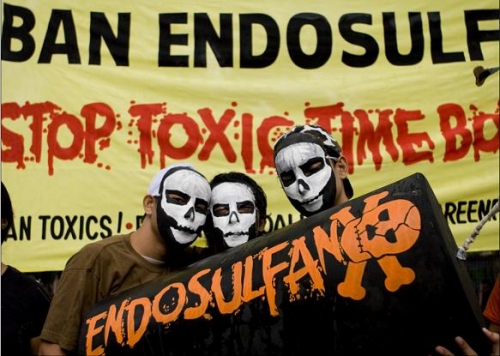| You are at Toxics Alert > News > Endosulfan poisoning in Padre village: Industry's dirty tactics | |||
 |
 |
||
|
Subscribe || Tell a Friend || Print View | ||
| Home | Editorial | Feature | Interview | News | Policy | Updates | Reports / International News | Partner | |||
|
|
Previous Article | Next Article Endosulfan poisoning in Padre village: Industry's dirty tacticsSource: CSE, Date: , 2010Pesticide industry body loses defamation case against CSE, twice
The Crop Care Federation of India (CCFI), a pesticide industry body, has twice lost the defamation case it filed against Centre for Science and Environment, New Delhi. CCFI had been pursuing the case against a study done by CSE highlighting the endosulfan poisoning of residents of Padre village in Kasaragod district, Kerala. After CSE’s study government scientific institutions had confirmed this and endosulfan use had been banned in the state by Union agriculture ministry. CCFI had initially filed a criminal defamation case at the Metropolitan Magistrate's Court in Bandra, Mumbai in 2006. In 2008 the learned magistrate rejected their complaint saying that the specific case was not defamatory. Then, CCFI challenged this order by filing a criminal revision application in the court of honourable Sessions Court. In June 2008, the Learned Sessions Judge also rejected their application saying that CSE’s report was not of defamatory nature. Significantly all through this, CSE and several of its staff including the director, despite being a party to the case were unaware of these criminal proceedings. Now the federation has filed an appeal in the Bombay High Court and finally CSE has been made aware of this case. The Honourable High Court has rejected the CCFI's appeal for an expeditious hearing and the case will come up in normal course.  Chronology of events February 28, 2001 - The endosulfan poisoning case in Kerala reported in DTE. High levels of endosulfan residues found in human and environment samples from Padre village, district Kasaragod, Kerala. A large number of people in the village had been, for years, suffering from horrendous diseases. The public outcry that followed led to the Kerala government banning endosulfan and the Indian Council for Medical Research ordering an investigation into the issue. August 25, 2001: Government of Kerala puts a ban on use of endosulfan in plantations in the state. March 2002: The agriculture secretary, Kerala, who’s also holding the additional post of state agriculture director, issues an order, lifting the ban on endosulfan. Only the ban on aerial spraying of endosulfan stays put. July 2002 - The investigation, carried out by the National Institute of Occupational Health, Ahmedabad, indicts endosulfan. July 15, 2002 - DTE carries an exposé on the kinds of dirty tactics used by the pesticide industry and how it connived with government officials and scientists in Kerala in an effort to get a clean chit for its product. July-August 2002 - In response Union government constitutes a committee, headed by Dubey. The committee was expected to probe the matter objectively and look into all the reports available on the matter. August 12, 2002: The Kerala High court bans the use of the endosulfan in the state of Kerala, pending a decision from the Central Insecticides Board (CIB) of the union government. A division bench, comprising Chief Justice B N Srikrishna and Justice G Sivarajan, banned the pesticide and made it clear that it cannot be used in any of its formulations or under any of its brand names. The interim order was passed on two public interest litigations filed by the Thiruvamkulam Nature Lovers Movement, the People’s Council for Social Justice and the Samatha Law Society seeking a ban on the deadly pesticide. March 2003 - Dubey brushed aside all dissent against endosulfan and gives a clean chit to the pesticide. September 2003: High power committee set up by Kerala government submits its report. Health department additional director was the convenor of the committee with members from the Kerala pollution control Board and the state agriculture department. The committee concludes that endosulfan is the cause of the health problems in Kasaragod. They recommend that health facilities be provided to the victims. April 15, 2004 - DTE gives evidence that report of the Dubey committee was manipulated. Evidence was suppressed and facts were distorted and half-truths (even full lies) reported to absolve endosulfan. Dubey completely ignored the report of NIOH, and the answers given by them to the queries raised, and instead chose to depend on the report of a private laboratory the Fredrick Institute of Plant Protection and Toxicology (FIPPAT) (now known as the International Institute of Bio-technology and Toxicology). DTE reported that FIPPAT had actually detected endosulfan residues in human blood samples but had not disclosed this in its final report. September 2004 - Again the Union government responds by setting up a committee headed by C D Mayee, then agriculture commissioner. December 2004 - Mayee committee submits report. Mayee committee (report marked For official use only) did not re-examine the FIPPAT issue. Neither did they re-look into all the aspects that Dubey committee had ignored. Ironically, Mayee committee completely depended on Dubey committee. The very committee whose criticism has led to its formation. Mayee also gives a clean chit to endosulfan. December 2004: State pollution control board bans the use of endosulfan in Kerala. August 2005 - DTE reports the details of Dubey committee report (again classified as For official use only and not publicly available till date) to inform its readers how Dubey had suppressed dissent and that majority of the scientific members in the committee had ruled against endosulfan. December-2005: Union ministry of agriculture issues gazette notification banning endosulfan in Kerala |
•
Home •
FEATURE •
INTERVIEW •
NEWS •
POLICY •
UPDATES •
REPORTS / INTERNATIONAL NEWS •